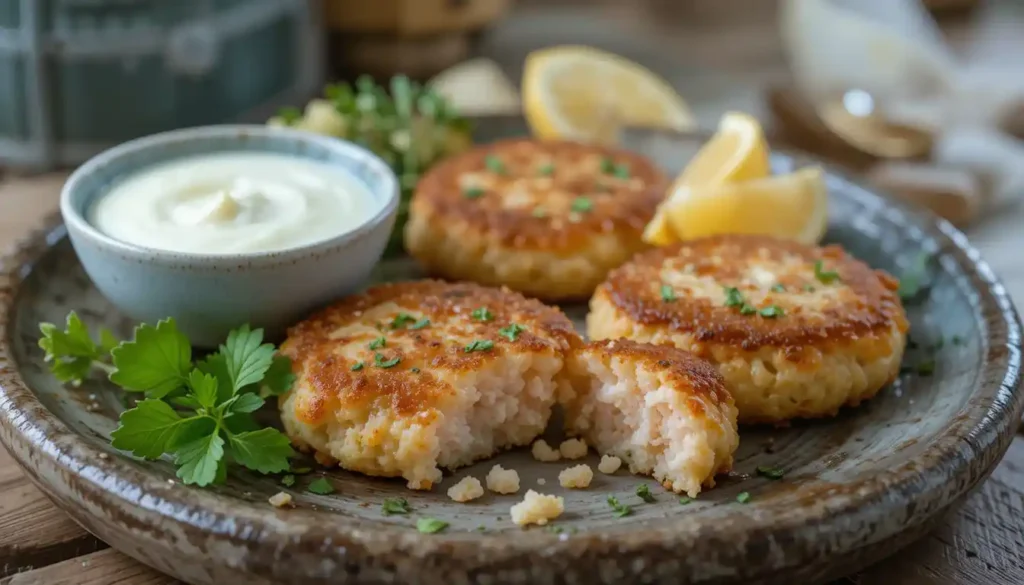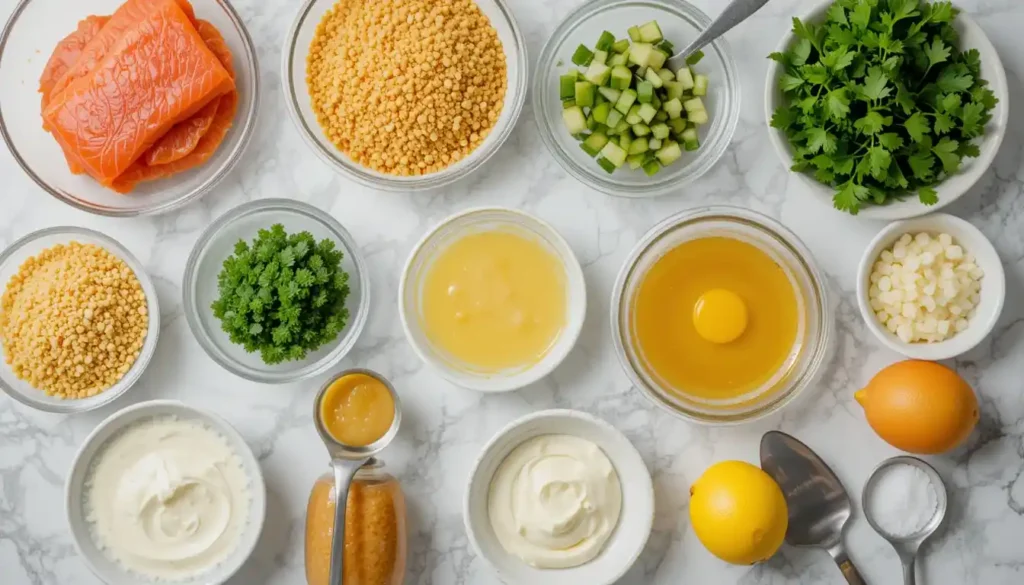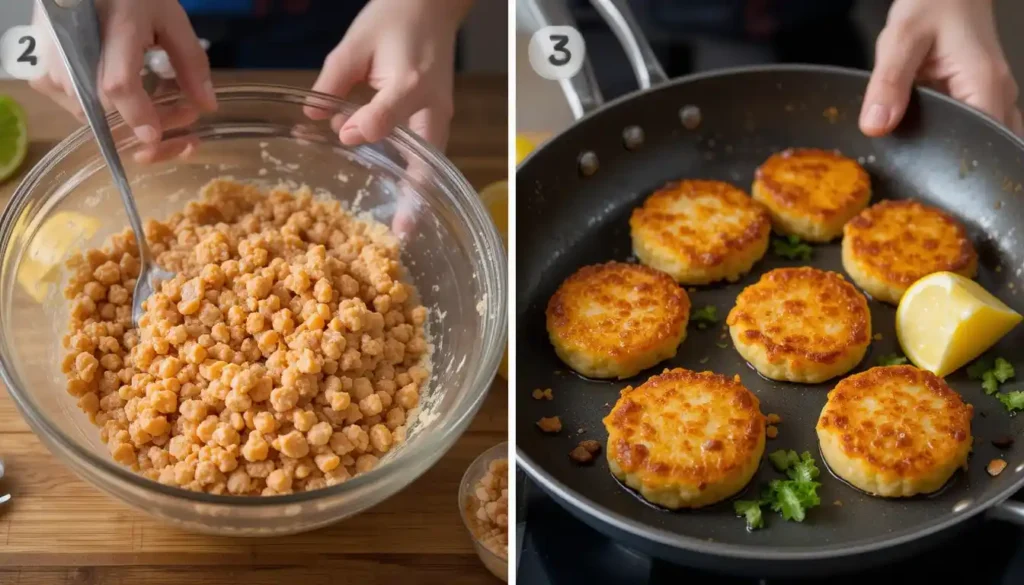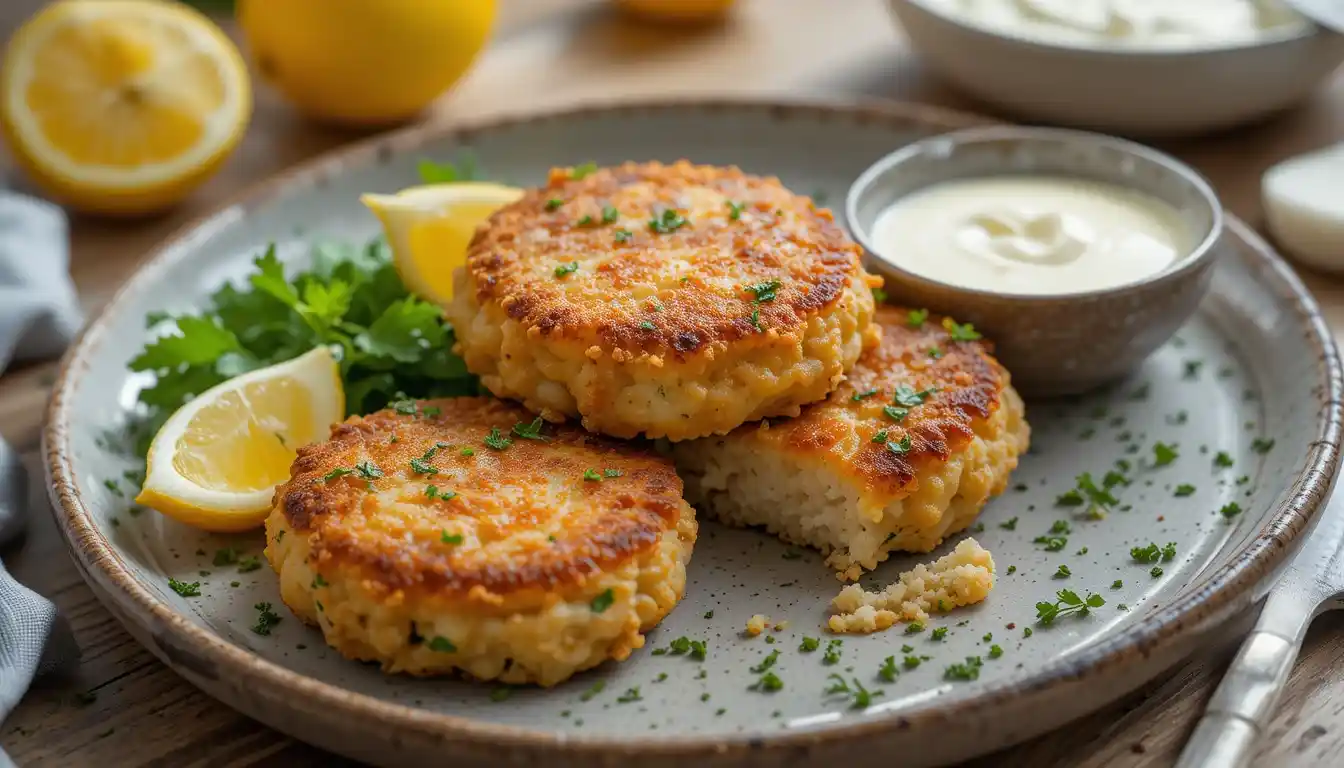Table of Contents
As Julia Child once said, “The only time to eat diet food is while you’re waiting for the steak to cook.” This quote perfectly encapsulates the indulgent joy of savoring a perfectly cooked salmon cake, crispy on the outside and flavorful on the inside.
You are about to discover a salmon cake recipe that transforms simple ingredients into an impressive meal. Whether you’re using fresh or canned salmon, this versatile dish is perfect for both weeknight dinners and special occasions.
These salmon cakes are not only delicious but also straightforward to make, yielding restaurant-quality results without the “fishy” taste some seafood recipes are known for. You can enjoy them with a variety of sauces and side dishes, making them a great addition to your meal repertoire.

What Makes These Salmon Cakes Special
With their crispy exterior and tender interior, these salmon cakes are a culinary delight. You can enjoy them in various settings, from a casual family dinner to a more formal gathering.
Flavor Profile and Texture
The salmon cakes offer a rich flavor profile, combining the freshness of salmon with a blend of herbs and spices. The texture is equally impressive, with a crunchy outside giving way to a tender, flaky inside. This contrast in textures adds to their appeal, making them a satisfying dinner option.
Versatility for Meals
These cakes are incredibly versatile. You can serve them as an elegant appetizer, a light lunch, or a satisfying dinner. They work well as patties in a sandwich or as the star of a main course. They can be part of a healthy meal plan, offering protein and omega-3 fatty acids. For a complete meal, consider pairing them with a green salad and tartar sauce for a delicious and healthy recipes combination.
| Meal Type | Pairing Suggestions |
|---|---|
| Brunch | Green salad with vinaigrette, tartar sauce |
| Dinner | Rice pilaf, roasted asparagus |
| Lunch | Sandwich filling, coleslaw |
Ingredients for Perfect Salmon Cakes
Making exceptional salmon cakes requires a thoughtful selection of ingredients. The quality of your salmon, whether fresh or canned, sets the foundation for the dish.

Fresh vs. Canned Salmon Options
When deciding between fresh and canned salmon, consider the flavor and texture you prefer. Fresh salmon provides a richer flavor, while canned salmon is more convenient.
Key Binding Ingredients
To hold your salmon cakes together, you’ll need ingredients like eggs and bread crumbs. The mixture provided includes 1 cup of bread crumbs and 2 beaten eggs, along with 3 Tbsp of mayo and 1 tsp of Worcestershire sauce.
Herbs and Seasonings
To elevate the flavor, incorporate fresh herbs like parsley and dill. A squeeze of lemon juice adds brightness, balancing the richness of the salmon. Season with pepper and a touch of salt. You can also add a hint of flavor with 1 tsp of garlic salt and 1/4 tsp of black pepper. For added depth, consider sautéed onions and a splash of lemon juice.
- Use fresh herbs like parsley and dill for added brightness and color.
- Balance the richness with a squeeze of lemon juice.
- Enhance flavors with proper seasoning using salt and pepper.
- Experiment with optional seasoning variations like Cajun or Mediterranean for different profiles.
Essential Equipment Needed
Before you start making salmon cakes, ensure you have the necessary equipment. To achieve the perfect golden crust and delicious flavor, you’ll need a few key tools.
A good non-stick skillet is crucial for cooking salmon cakes without them sticking. Heat a medium skillet over medium heat, add 1 Tbsp olive oil and 1 Tbsp butter, and sauté finely diced onion and bell pepper until softened and golden (7-9 minutes). This step is essential for developing the flavor of your salmon cakes.
- A fish spatula or wide turner helps flip the delicate patties without breaking them.
- Mixing bowls of various sizes help organize ingredients and combine them properly.
- Measuring cups and spoons ensure consistent results every time.
Other helpful tools include a food processor for chopping ingredients, although it’s not essential. Parchment paper or a silicone baking mat can be useful when forming and storing patties. Most home cooks already have these necessary equipment items, making this recipe accessible.
| Equipment | Purpose |
|---|---|
| Non-stick Skillet | Cooking salmon cakes without sticking |
| Fish Spatula/Wide Turner | Flipping delicate patties |
| Mixing Bowls | Organizing and combining ingredients |
| Measuring Cups/Spoons | Ensuring consistent results |
| Wire Cooling Rack | Draining excess oil from cooked salmon cakes |
Step-by-Step Salmon Cake Recipe
Now that we have the ingredients and equipment ready, let’s dive into the step-by-step process of making delicious salmon cakes. This recipe will guide you through preparing, mixing, forming, and cooking the perfect salmon cakes.

Preparing the Salmon
The first step in making salmon cakes is preparing the salmon. If you’re using fresh salmon, ensure it’s cooked and flaked. For canned salmon, drain the liquid and remove any skin or bones. You should have about 1 cup of flaked salmon for the recipe. Properly preparing the salmon is crucial for the texture and flavor of your salmon cakes.
Making the Mixture
In a large bowl, combine the flaked salmon, panko breadcrumbs, finely chopped onion, minced garlic, beaten eggs, mayonnaise, Dijon mustard, chopped parsley, salt, and pepper. Mix everything together until just combined. Be careful not to overmix, as this can make the salmon cakes dense. The mixture should be cohesive but still retain some texture.
Forming and Coating the Patties
Using your hands, shape the mixture into patties, about 1 1/2 inches in diameter and 1/2 inch thick. You should end up with around 8-10 patties. Coat each patty lightly with additional panko breadcrumbs. This coating will help achieve a crispy exterior when cooking.
Cooking to Golden Perfection
Heat 1 Tbsp of oil and 1 Tbsp of butter in a large skillet over medium heat. Once the butter is sizzling, add half of the salmon cakes. Cook for 3 1/2 to 4 minutes per side, or until they are golden brown and cooked through. If the salmon cakes brown too quickly, reduce the heat to prevent burning. Remove the cooked salmon cakes to a paper-towel-lined plate to drain excess oil. Repeat the process with the remaining salmon cakes, using the remaining 1 Tbsp of oil and 1 Tbsp of butter.
| Cooking Step | Time/Temperature | Notes |
|---|---|---|
| Heat oil and butter | Medium heat | Use a large skillet |
| Cook first batch of salmon cakes | 3 1/2 to 4 minutes per side | Until golden brown |
| Cook second batch | Same as first batch | Adjust heat if necessary |
As a tip from experienced chefs, “The key to a great salmon cake is not just the ingredients, but how you cook them. A nice golden brown crust makes all the difference.” – Chef’s Guide to Seafood. Ensuring your salmon cakes are cooked to a golden brown on the outside while remaining moist on the inside is crucial. Adjusting the heat as needed and not overcrowding the skillet are key factors in achieving this.
Pro Tips for Crispy Salmon Cakes
To make salmon cakes that are crispy on the outside and tender on the inside, follow these pro tips. Achieving the perfect balance of texture and flavor requires attention to detail and a few expert tricks.
Texture Troubleshooting
For crispy salmon cakes, it’s crucial to manage the moisture content and coating effectively. Ensuring the salmon is not too wet and using the right coating, such as a mixture of flour, cornmeal, and a pinch of salt, can significantly improve the texture. When you add the egg, onion, cornmeal, flour, parsley, hot sauce, lemon juice, and seasoned salt to the bowl with the salmon, stir until well combined, being mindful of the mixture’s consistency.
Flavor Enhancements
Enhancing the flavor of salmon cakes can be achieved by balancing the ingredients and adding complementary flavors. Using fresh herbs like parsley, a squeeze of lemon juice, and a dash of black pepper can elevate the dish. You can also experiment with different seasonings such as Cajun or Mediterranean to give your salmon cakes a unique twist. For instance, adding a tsp of hot sauce can add a nice kick.
| Flavor Profile | Key Ingredients |
|---|---|
| Cajun | Hot sauce, paprika, garlic powder |
| Mediterranean | Lemon zest, oregano, olives |
| Asian-Inspired | Soy sauce, ginger, sesame oil |
Serving Suggestions and Pairings
To elevate your dinner, consider the versatile pairing options for salmon cakes. Salmon patties can be served in various ways to suit different tastes and dietary needs.
Sauce Recommendations
Enhance your salmon cakes with a variety of sauces. A tartar sauce or a remoulade can add a rich, tangy flavor. For a lighter option, a lemon-dill sauce can complement the salmon nicely.
Side Dish Ideas
Pair your salmon cakes with a range of side dishes for a complete meal. Roasted vegetables, quinoa salad, or a simple green salad are all excellent choices. For a heartier meal, consider serving with mashed potatoes or sweet potato fries.
Meal Planning Options
You can prep salmon cakes ahead of time for a quick dinner. They can be refrigerated for several hours or frozen for later use. Simply reheat in the oven at 350°F for 10-15 minutes, saving you time on busy days.
| Meal Idea | Prep Time | Pairing Suggestion |
|---|---|---|
| Salmon Cakes with Roasted Vegetables | 30 minutes | Tartar Sauce |
| Salmon Patties with Quinoa Salad | 20 minutes | Lemon-Dill Sauce |
| Salmon Cakes with Mashed Potatoes | 40 minutes | Remoulade |
Make-Ahead and Storage Information
Making salmon cakes ahead of time requires careful storage to preserve their flavor and texture. Whether you’re preparing for a busy week or saving leftovers, understanding the best storage methods is crucial.
Refrigeration Guidelines
For short-term storage, refrigerate your salmon cakes within two hours of cooking. Place them in an airtight container, separating layers with parchment paper to prevent sticking. They will keep for up to 3 days in the refrigerator. When you’re ready to eat them, simply reheat the salmon patties in a pan with a moderate heat until they’re warmed through.
Freezing and Reheating Instructions
For longer storage, you can freeze your salmon cakes. First, lay the cooked and cooled salmon cakes on a foil-lined baking sheet in a single layer, cover loosely with plastic wrap, and freeze for about an hour. Once frozen, wrap each cake individually in plastic wrap and store them together in a freezer bag or airtight container. They can be frozen for up to 3 months. To reheat, thaw overnight in the refrigerator, then reheat in the oven, on the stovetop, or in the microwave. Reheating salmon patties from frozen may take a few extra minutes, so adjust your time accordingly.
Conclusion
With this salmon cake recipe, you’ll create deliciously crispy patties that are sure to become a staple. The versatility of salmon cakes makes them perfect for various meals and occasions. They offer a delicious flavor, crispy texture, and significant nutritional value. Feel free to experiment with different seasonings and serving suggestions. Even novice cooks can achieve excellent results with this straightforward recipe. This salmon dish is a great way to introduce seafood to hesitant eaters. This post may contain affiliate links to help you create perfect cakes.
FAQ
Can I use fresh salmon instead of canned for this recipe?
Yes, you can use fresh salmon. Simply cook and flake it before mixing with other ingredients. Keep in mind that fresh salmon may have a different moisture content, so you may need to adjust the amount of binding ingredients.
How do I prevent my patties from breaking apart while cooking?
To prevent patties from breaking apart, make sure to chill them in the refrigerator for at least 30 minutes before cooking. Also, handle them gently when placing them in the skillet, and avoid overcrowding the pan.
What is the best oil to use for cooking salmon cakes?
You can use any neutral-tasting oil with a high smoke point, such as canola or avocado oil, for cooking salmon cakes. Heat about 1/2 inch (1 cm) of oil in a skillet over medium heat.
Can I make salmon cakes ahead of time?
Yes, you can prepare the mixture and form the patties ahead of time. Store them in the refrigerator for up to a day or freeze them for later use. When you’re ready to cook, simply thaw frozen patties and cook as directed.
What are some good sauce recommendations for serving with salmon cakes?
Tartar sauce is a classic choice, but you can also try a lemon-dill sauce or a remoulade. For a lighter option, a squeeze of fresh lemon juice and a sprinkle of chopped herbs can be a great accompaniment.
How do I achieve a crispy exterior on my salmon cakes?
To achieve a crispy exterior, make sure to coat the patties evenly with breadcrumbs or panko before cooking. Cooking them in a skillet with the right amount of oil over medium heat will also help to crisp up the exterior.


1 thought on “Salmon Cake Recipe: Crispy, Savory, and Satisfying”
Comments are closed.